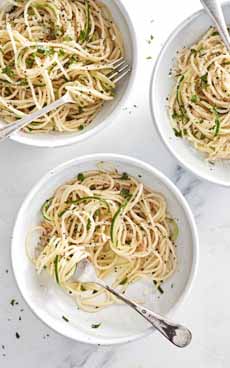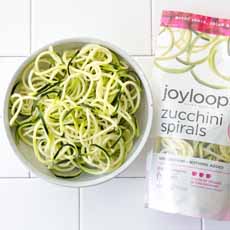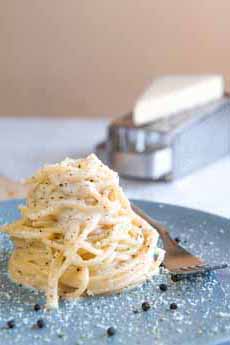TIP OF THE DAY: Mix Spaghetti With Zucchini Noodles
 [1] Cacio e Pepe, “cut” with zucchini noodles (photos #1 and #2 © Good Eggs).
|
Two years ago, when zucchini noodles became the rage, many of us ran out to buy spiralizers—simple gadgets that turned a zucchini into ribbons of vegetable “pasta.” You can now buy spiralized zucchini in bags. A big bowl of pasta with Bolognese sauce and lots of grated cheese can be lightened, both texturally and calorically, and is an attractive substitute. We’ve previously written about Cacio e Peppe (KAH-chee-oh ay PEP-pay, cheese and pepper), an ancient pasta dish (in fact, one of the most ancient dishes in Italian cuisine). The classic recipe is a quick one Grated cheese—cacio in Roman dialect, referring to a sheep’s milk cheese like pecorino romano—becomes a creamy, cheesy sauce when mixed with a a few spoons of the hot water used to cook the pasta. The result: creamy sauce, obtained by combining the best quality Pecorino Romano and a few spoons of the water used to cook the spaghetti. The starch that leaches from the spaghetti into the cooking water combines with the grated cheese in just the right way. But Good Eggs has taken it one step further in the name of lowering the carbs: They mixed conventional wheat pasta noodles with zucchini noodles. The recipe is below, but first: Cacio e Pepe, a Roman dish, was an easy comfort food. The ingredients were very portable and did not spoil. Roman shepherds and travelers needed only water and a fire to create a stick-to-your-ribs meal. The classic recipe has no butter or cream, ingredients which are used to make creamy Alfredo sauce. There’s just pasta, salted water to cook it, cheese, and ground black pepper. Some modern recipes use a bit of olive oil to bind the ingredients. All the ingredients are ancient foods: |
|
|
Ready to combine the ingredients into a hot dish of pasta…with some zucchini? RECIPE: CACIO & PEPE WITH PASTA & ZUCCHINI NOODLES Ingredients For 2 Main Course Servings 1. BRING a large pot of salted water to a boil. While it heats, place the zucchini in a saucepan over medium heat and sauté for about 2 minutes, until al dente. Turn the heat off and cover the zucchini to keep it warm. 2. COOK the spaghetti according to package directions; then drain it, holding back a few tablespoons of pasta water. Add the pasta and half the pasta water to the zucchini pan, and toss together. 3. REMOVE from the heat and toss with the cheese and pepper to taste (Italians go heavy on the pepper). The heat of the pasta and the pasta water should help melt the cheese into a smooth, creamy sauce. Add more hot pasta water as needed to achieve the consistency you desire. If the water has become tepid, microwave it for 30 seconds. 4. GARNISH with parsley and serve. It isn’t part of the official recipe, but we like the crunch of toasted bread crumbs or croutons as a garnish. ________________ *Humans can’t live without some sodium. It’s needed to transmit nerve impulses, contract and relax muscle fibers (including the heart muscle and blood vessels), and maintain a proper fluid balance. Here’s more about it from Harvard Medical School. †Long, thin spaghetti has different names in different regions of Italy; for example, capellini, fedelini, spaghetti alla chitarra and tonnarelli. Spaghetti alla chitarra, also known as maccheroni alla chitarra, is a variety of egg pasta typical of the Abruzzo region in Italy, with a square cross-section about 2–3 mm thick. Tonnarelli is a similar pasta from the Lazio region. In the U.S., you’re most likely to find spaghetti, spaghettini, and vermicelli (angel hair, capelli d’angelo, is too thin for this rich sauce). The widths of all of these strands vary, but not in a significant way to impact the recipe.
|
||

